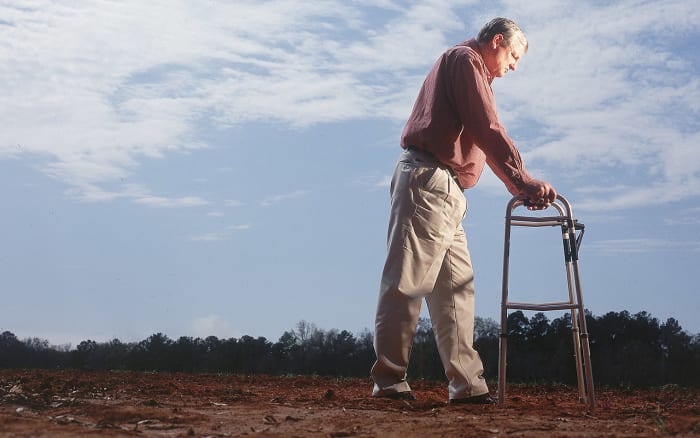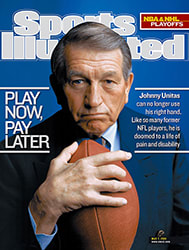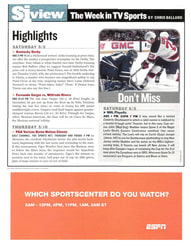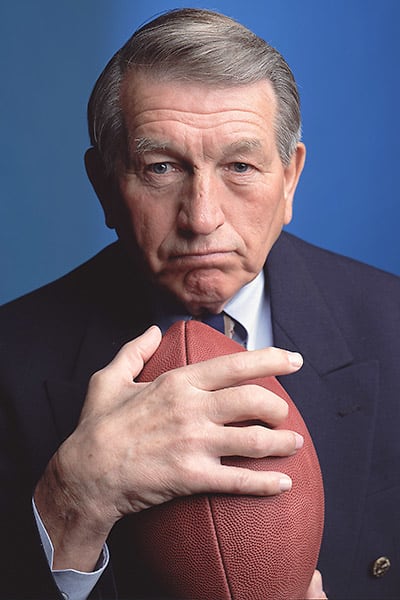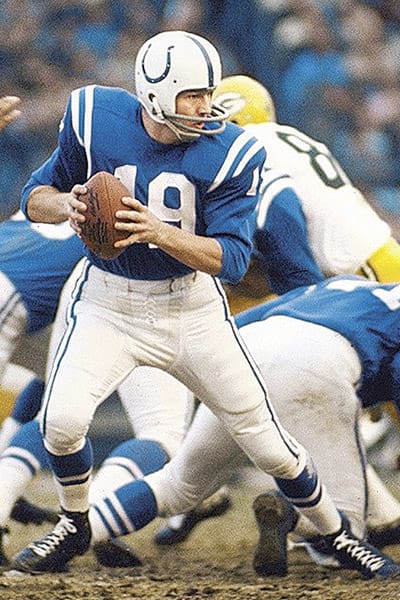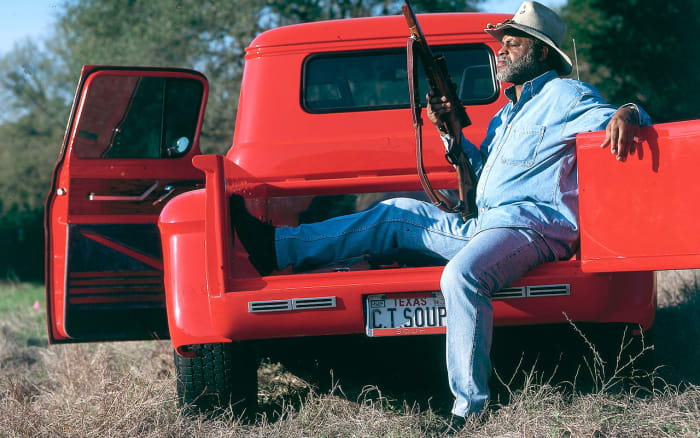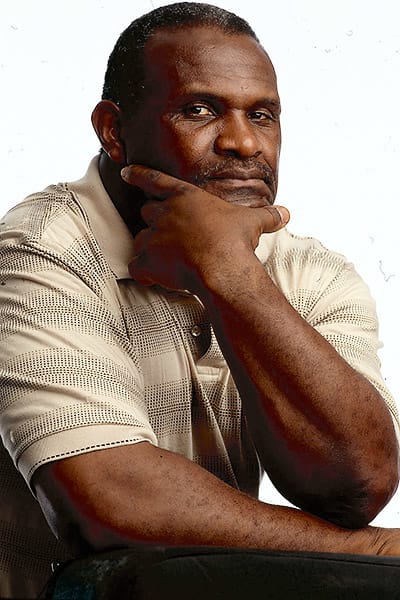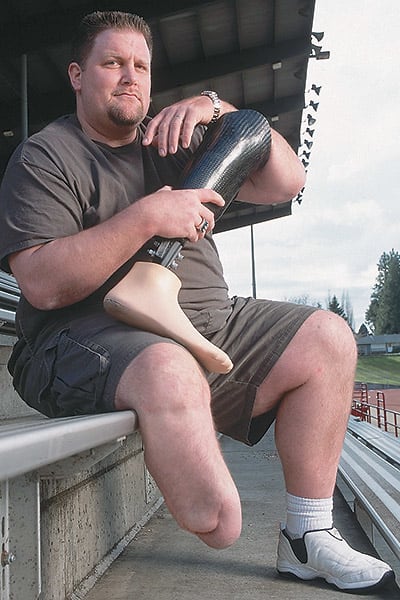The Wrecking Yard
They are the wincing, hobbling wounded: the men who played professional football, a notoriously joint-shearing, disk-popping, nerve-numbing exercise that has grown only more dangerous since Curt Marsh last crashed into a defensive lineman as a Los Angeles Raider.
"If you go to a retired players' convention, there are older retirees who walk around like Maryland crabs," says Miki Yaras-Davis, director of benefits for the NFL Players Association. "It's an orthopedic surgeon's dream. I'm surprised the doctors aren't standing outside the door handing out their cards. Hardly one [former player] you see doesn't need a hip replacement. Everybody comes out of pro football with some injury. It's only the degree that separates them."
A 1990 Ball State study, commissioned by the NFLPA and covering the previous 50 years of league history, revealed that among 870 former players responding to a survey, 65% had suffered a "major injury" while playing--that is, an injury that either required surgery or forced them to miss at least eight games. The study also reported that the percentage of players incurring such injuries had increased alarmingly: from 42% before 1959 to 72% in the 1980s, after many stadiums had switched from grass to artificial turf. Two of every three former players disclosed that their football injuries had limited their ability to participate in sports and other recreation in retirement, and more than half of them also had a curtailed ability to do physical labor. Of those who played during the '70s and '80s, nearly half (50% and 48%, respectively) reported that they had retired because of injury—up from 30% in the years before 1959.
There's little doubt, based on a follow-up survey in 1994 and on
considerable anecdotal evidence, that injuries in the NFL are
becoming more serious and frequent as the colliding bodies grow
bigger and stronger. The 300-pound-plus Sira-goosed lineman, a
rarity 40 years ago, is today as common as the soccer-style
kicker. James Andrews, a leading orthopedic surgeon who has been
operating on pro football players for almost 30 years, sees a
correlation between the worsening of injuries and the size and
power of the modern player. In fact, Andrews, who works out of
the HealthSouth Medical Center in Birmingham, is witnessing the
rise of a phenomenon that was almost unheard of only 15 years
ago.
"The incidence of serious, noncontact knee injuries is much
higher than it used to be," he says. Artificial turf is only part
of the problem. "These athletes are bigger, stronger and running
faster, and they're tearing up knees from cutting, changing
direction on a dime," Andrews says. "In fact, the incidence of
anterior cruciate ligament injuries is higher from noncontact
than contact. I've seen guys get significant injuries just
falling on the football. It's like a big tree falling."
Indeed, among the most notable casualties of noncontact incidents
are two gifted running backs: Jamal Anderson and Ki-Jana Carter.
Anderson, of the Atlanta Falcons, missed all but two games in
1999 after tearing the ACL in his right knee during a Monday
Night Football game on artificial turf; his foot got snagged in
the rug, and Anderson went one way as his popping knee went
another. Carter, the top pick in the 1995 draft, tore his left
ACL in his rookie year by simply "twisting" the knee, says
Andrews. The former Penn State star was cut by the Cincinnati
Bengals last June and hasn't been picked up by another team.
As for the New Age tyrannosaurs battling in the trenches, they
have become so large and powerful that injuries have risen
alarmingly in their hand-to-hand combat. "They are exerting
forces strong enough to dislocate their elbows and shoulders
forward and backward," Andrews says. "With the blocking
techniques we're seeing, there's an increased incidence of
offensive linemen's shoulders being dislocated."
Some players have quit rather than court more pain. A teary-eyed
John Elway, claiming he still had a passion for the game at age
38, retired two years ago because his body could no longer take
the punishment. Minnesota Vikings running back Robert Smith, 28,
an unrestricted free agent at the height of his game, astounded
the NFL in February by retiring without explanation, turning his
back on what was expected to be a lively bidding war, with offers
likely to exceed $30 million for five years. Smith had already
had three knee surgeries, and while his agent, Neil Cornrich,
denied that the on-the-job pounding played any part in the
running back's decision to leave the game, Smith had implied as
much to reporters. (Another running back, Curtis Enis, retired
last week at 24 because of a degenerative condition in his left
knee. Enis, the No. 5 pick in the 1998 draft, tore a ligament in
that knee during his rookie season, with the Chicago Bears.)
No matter how young they are when they retire, a great many NFL
players face a visit in middle age from that most pernicious of
postfootball afflictions, degenerative arthritis. An athlete who
suffers an injury to a major weight-bearing joint, such as the
hip or knee, is five to seven times more likely to develop
degenerative arthritis than an average member of the population.
Repeated pounding and jarring of the joints—even in the absence
of injury—all but guarantee that former players will be caught in
the ganglia of serious and chronic pain. The 1994 NFLPA-Ball
State survey said that arthritis is the most commonly reported
health problem among retired players, affecting 47% of
respondents.
"A lot of ex-players with terribly arthritic spines say, 'But I
never had a back injury!'" Andrews says. "That doesn't matter.
There's no way to heal those cartilage lesions. They heal with
scar tissue and are never as good again. What you end up with is
a bunch of ex-NFL players, in their 40s and 50s, who shouldn't
have arthritis but have degenerated knees and need total
replacement done at an early age."
This, then, is not about a few casualties wandering off the
playing field into retirement, their bells rung and still chiming
in their heads, but rather about a whole society of broken men
hounded through their lives by pain and injury, and all the
psychological problems that often attend them.
Johnny Unitas once owned the most dangerous right arm in the NFL.
Today he barely has use of the hand attached to it. Unitas, who
is considered by many to be the greatest field general to play
the game, is still paying for a hit he took more than three
decades ago as a Baltimore Colt. That day in 1968, Unitas was
drawing back his arm to throw a pass when a Dallas Cowboy mashed
the inside of his elbow. Unitas came back to play again--the arm
seemed fine up through his retirement in 1974—but by the
mid-1990s he was having problems with the nerves that controlled
his hand and fingers. He lost strength and feeling in the hand
and became unable to rotate the thumb back and grasp objects. The
symptoms only got worse. Now Unitas cannot close the hand that
made Raymond Berry famous.
Unitas's two knee replacements work perfectly well—cartilage and
ligaments in the right knee were torn in a collision with two
Bears in 1963, while the left wore out from years of favoring the
right--but when he plays golf, which is about all the exercise he
can get with those knees, he has to use his left hand to close
the fingers of his gloved right hand around the grip, then strap
the hand to the shaft with a Velcro strip. He goes through this
tedium on every shot. "I do it putting, too," says Johnny U,
who's 68.
Forty years ago Unitas was the toughest and smartest quarterback in the game, calling the plays and running the show in a way that inspired both fear and awe among teammates and opponents alike. Mentally, he always seemed a step ahead of everyone else. If a situation looked ripe for a pass, Unitas would signal a run; if it called for a run, he'd throw a pass. If it called for a pass and his opponents, trying to outguess him, set up for a run, he'd throw. Unitas perfected the two-minute drill, and no one since—not Montana, not Elway—has run it better.
Setting an NFL record that seems as unassailable as Joe
DiMaggio's 56-game hitting streak, Unitas threw a touchdown pass
in 47 consecutive games between 1956 and 1960. In the years
since, only Dan Marino has come anywhere close to that mark,
throwing scoring passes in 30 straight games from 1985 to '87.
Unitas has demanded disability compensation from the league but
says he has been turned down for various reasons, among them that
he didn't apply by age 55—though his right hand didn't fail him
until he was 60—and that the league pays him a pension of $4,000
a month. The NFL adds that, in its opinion, Unitas is not
"totally and permanently disabled."
Meanwhile, of that magical hand that spun footballs like strands
of gold, Unitas says, "I have no strength in the fingers. I can't
use a hammer or saw around the house. I can't button buttons. I
can't use zippers. Very difficult to tie shoes. I can't brush my
teeth with it, because I can't hold a brush. I can't hold a fork
with the right hand. I can't pick this phone up....You give me a
full cup of coffee, and I can't hold it. I can't comb my hair."
Bill Stanfill never thought it would come to this. Never
conceived, through all his years as a rampaging defensive end for
the Miami Dolphins, that he would be reduced to what he is now.
Never imagined that at 54, he would be navigating his house in
Georgia with a metal walker—step-shuffle, step-shuffle—as he
recovered from hip-replacement surgery. Or still feeling the
consequences of that near-fatal injury he suffered when, during a
preseason game against the Bengals in 1975, he cracked heads with
teammate Vern Den Herder and almost severed his spinal cord
between vertebrae C-4 and C-3.
It was like nothing he had ever felt. "I'd had stingers, but this
was entirely different," Stanfill recalls. "I just numbed up.
Could not move my arms or feel myself breathing." Stanfill had
subluxed the joint in his cervical spine; that is, a disk and the
surrounding bone had slipped nearly far enough to damage the
cord. Stanfill would never be the same player again, and by the
end of the next year he would be out of football. Two decades
later, in the mid-'90s, the disks began herniating, and he has
had four vertebrae fused in his cervical spine.
"I can't tip my head back at all," says Stanfill, an avid bird
hunter, "so I can't shoot dove anymore. I feel like I swallowed a
Viagra pill and it got stuck in my throat. My neck is stiff as
hell. The neurosurgeons have told me that if another disk goes
[in my cervical spine], I will be totally disabled."
Stanfill was an old-fashioned football gladiator, a 6'5 1/2",
255-pound country boy who won the Outland Trophy, as the college
game's best interior lineman, in his senior year at Georgia;
helped Miami win two Super Bowls, after the 1972 and '73 seasons;
and was named to four Pro Bowls. He relished the battle in the
trenches, mano a mano. "All I wanted to do was play," he says.
All those wars left all those scars, however, and not only to his
spine. In late January, while sitting next to the fireplace in
his five-bedroom redbrick house outside Albany, Ga., Stanfill
pointed out a glass jar sitting on the mantel. At the bottom of
the jar, immersed in a clear solution, was a mysterious white
ball. "I'm gonna see if I can donate it for auction," he said.
"'Who wants a piece of Bill Stanfill?' That's part of me. The
price I paid for playing pro football."
It was the ball of his left hip, and it had been sawed off his
skeleton three weeks earlier. Stanfill had been suffering from
avascular necrosis (AVN)—in which blood circulation is cut off to
the hip bone, causing it to die—because of repeated trauma and,
possibly, repeated injection of the anti-inflammatory drug
cortisone when he was in pro ball. ("I was like a pincushion," he
says.) Stanfill sells agricultural real estate, but he has worked
little since March 2000, when a disk in his lower back ruptured.
Doctors have told him that his right hip also has AVN and will
have to be replaced.
Stanfill's football days have left him a physical wreck, making
him wonder what his life will be like in five years. Still, he
expresses neither rancor nor self-pity. "Just wish I'd made some
of the money they're making today," he says wryly. "It would make
this a lot easier to live with."
Earl Campbell has a dazzling assortment of rings that were given
to him in honor of his storied accomplishments as a college and
pro running back: the Heisman Trophy ring, the NFL Rookie of the
Year ring, one MVP ring (though he was MVP three times) and the
NFL Hall of Fame ring, but he wears none of them because of
arthritis in both his hands, the ones that he used to push away
pursuing tacklers. "Jim Brown and I were the best at the
stiff-arm," says Campbell. "Now I can barely close my left
fist—the arthritis and the soreness and the pain."
Campbell was a complete force as a running back, fast enough to
turn the corner and race upfield, strong enough to crash through
the line. He always seemed to be running out of his clothes; it
was as if he invented the tear-away jersey. The abiding memory of
Campbell is that of a man charging down the field with three
defenders clinging to his back. It was easy to imagine him in the
end zone dressed in nothing more than his jockstrap and shoulder
pads, standing there with a quizzical smile on his face and
various large bodies scattered behind him, each clutching a
remnant of his uniform. As his Houston Oilers coach, Bum
Phillips, said, "Earl Campbell may not be in a class by himself,
but whatever class he's in, it doesn't take long to call roll."
Now 46 and the owner of a barbecue restaurant and a
sausage-making business in Austin, Campbell winces at more than
his swollen digits. His knees and back ache ceaselessly. He also
has a condition called drop foot: As a result of nerve damage to
his legs, he cannot raise the front of his feet when he lifts
them off the ground to take a step. The feet flop along loosely
when he walks. To use the bathroom upstairs from his home office,
Campbell--unable to grip with his hands or bend his knees--must
lean his forearms on the railings and drag himself up the eight
or 10 steps. The process is as painful to watch as it must be for
Campbell to complete.
"I realize that every time you get something in life, you've got
to give up something," he says. He likes to hunt deer and wild
boar in south Texas, and he is reminded of what he gave the game
whenever he is home on the range. "Sometimes it gets to the point
that I can't stand the pain, like when I've got to walk a lot,"
he says. "Thank God I'm with people who understand me: 'Take all
the time you need.' It's embarrassing when I've got to hop onto
the back of a pickup and I need help. Or I need help climbing
into deer blinds.
"Sometimes I tell my wife, 'Shoot, if I knew it was going to hurt
like this, I don't know if I'd have [played football].' It's a
hell of a price to pay."
For most NFL players, especially linemen, weight training is as
much a part of the daily regimen as stretching exercises--and the
weight room works its own form of wickedness. Hoisting iron,
players rupture the patella tendons in their knees, put enormous
strain on their lower backs and cause ligament injuries to the
lumbar spine. They even damage their shoulders by doing something
the joint was not designed to do: bench-pressing huge weights.
Joe Jacoby, a former Washington Redskins offensive lineman, was a
habitue of the Skins' weight room, squat lifting his afternoons
away. He dare not lift weights anymore, for fear it will
accelerate the deterioration of his ankles, knees, wrists, elbows
and back. Jacoby still feels the echoes of years spent snatching
iron and leaning his sequoia body into snot-blowing defensive
linemen who drove shuddering forces down his spine and onto his
lower joints.
At 6'7", 305 pounds, Jacoby was a giant among the Hogs, a 13-year
veteran who retired in 1993, the year he collapsed in his
bathroom at home and could not get up. "My lower back went out,"
he says. "I dropped to my knees on the floor. The pain was that
sharp. I crawled out of the bathroom to the bed." Like Stanfill,
imbued with the ethic to play in pain, Jacoby played again later
that year. Then, against the Kansas City Chiefs, his back went
out again. He ended up spending three days in a hospital.
"I never wanted to go out that way," says Jacoby, 41. "I wanted
to keep playing, even though I was hurting. I felt like I was
letting down the team. You've been brought up that way since high
school. It's ingrained in you. I had a wife. I had a family. A
business I was starting. But I kept hearing those little things
in the back of my mind: You're letting your team down." He was in
traction, shot up with cortisone, when the thought finally struck
him: I can't keep doing this. I have a life to live after this.
Jacoby had blown out his left knee earlier in his career, when
his leg got wrenched in a pileup during a field goal attempt.
"The kneecap was way over on the side of the knee," he recalls.
"I still hear the crunching and popping." Another old
wound—vintage for linemen, who are forever getting their fingers
caught and dislocated in face masks and shoulder pads--is the
busted knuckle on Jacoby's wedding-band finger, as gnarled as a
tree root. He has won many wagers in bars, claiming he can get
the ring over that knuckle. His wife, Irene, had the band made
with a clasp, so he can take it off like a bracelet.
Jacoby owns an auto dealership in Warrenton, Va. He and Irene had
the sinks in the kitchen and master bathroom of their house
installed higher than normal, "so he doesn't have to bend down,"
she says. He often walks about sockless in loafers. "It's too
painful for him to bend over and put on socks or lace up shoes,"
Irene says.
Jacoby walks stiffly on his damaged ankles, but he endures the
discomforts with stoic grace. He still remembers vividly the
pounding he took year after year, through 170 games, including
four Super Bowls--a career that left him unable to do any exercise
other than walking. "Some days the back gets unbearable," he
says. "It's really deep in the lower back and goes down to my
left buttock and hamstring. Sometimes it gets so bad it hurts my
nuts. There's pain down my left leg now. My left foot has been
numb for two months. The bone's pressing on the nerve. Too many
years of abuse, using the back to block."
Like so many other hobbled former players, Jacoby says he would
do it all again if he had the chance. He knew what he was getting
into. "Football players know the risk and the consequences," he
says. "They know they will pay for it later in life. If they
don't, they are misleading themselves."
As much as Jacoby has gone through, he looks fortunate when
compared with Chris Washington. Only 39, Washington seems old
beyond his years. He was an NFL linebacker for seven seasons,
most of them with the Tampa Bay Buccaneers, and he has had 21
operations. He suffers from severe arthritis in both knees—he has
had six surgeries on the right, five on the left--and his right
thigh and calf are atrophying. He endures his days with help from
a pharmacopia in a kitchen cabinet: one pill for sleep, two for
pain (including double-strength codeine) and two to reduce
inflammation.
Washington was a zealous weightlifter, but now his home looks
like a Gold's Gym after closing, with everything racked and idle:
the stationary bike, the treadmill, the stair-climber and tons of
barbells. He won't use any of them for fear of inflaming his
diseased joints. Not only is he virtually crippled by ailing
knees, but he also suffers hand tremors from pinched nerves; he
shakes too much to fasten a necklace around his wife's neck.
Although he has upper arms like ham shanks, he experiences
periodic loss of strength in the right one and has back spasms as
well. Washington carries his 10-month-old daughter, Taylor, in a
Snugli, but not simply for convenience. He fears he will be
seized by a shooting pain in his back or arm or suffer the sudden
collapse of a knee and drop her—or, worse, fall on her.
Washington, who has worked as an insurance salesman and a
data-entry clerk after retiring from the NFL in 1992, has been
unable to hold a job since 1996. He draws disability payments to
help support his family and is seeing his worst fears slide
before his eyes. "Not being able to run around and play with my
daughter," he says, giving one example. "I tried coaching [as a
volunteer at the high school level], but my body couldn't take
it; I can't stay on my feet that long. What kind of an example am
I setting for kids if I'm walking around with a cane? I don't go
to a lot of NFL functions. I would like to hang out with those
guys, but I don't want them to see me like this."
None of this comes in the tone of a complaint. Washington wishes
only that when he played he had known more about what he was
doing to his body and had taken better care of it. He wishes that
he had not allowed himself to be shot up with painkillers and
cortisone so he could play hurt. Like the other former players
who have been down that tortuous road, he assumes his share of
the blame. "It was my choice to do what I did," he says. "I guess
I didn't expect to be in this kind of shape."
Nor did Harry Carson, for 13 years a crushing, headfirst inside
linebacker of the New York Giants. Carson's injury is to a human
organ that is still little understood. By his own count he
suffered at least 15 concussions while playing pro football, from
1976 to '88, and he is afflicted by what Yaras-Davis, of the
NFLPA, believes is one of the most common and troublesome
maladies among former players: postconcussion syndrome, which is
marked by headaches, forgetfulness, blurred vision and difficulty
tracking mentally.
Former Cowboys quarterback Troy Aikman and former San Francisco
49ers quarterback Steve Young, each of whom has suffered repeated
bell-ringers on the field, are the players most closely
associated with concussions. Carson, however, was one of the
first former players to go public with the debilitating
aftershocks of concussions, in an attempt to broaden
understanding of the problem. Carson had his share of other
injuries, but none quite as stunning as the concussion he
suffered in 1985 when he crashed head-on into his favorite
opponent, Redskins fullback John Riggins. "It was pretty much my
power against his power," Carson says. "I remember hitting John
and going back to the huddle...everything faded to black. I was
literally out on my feet."
Carson would find that such blows had long-term effects. In 1991,
three years after he retired, he wrote in his journal, "I don't
think as clearly as I used to. Nor is my speech, diction,
selection of vocabulary as good as it used to be, and I don't
know why." As a TV broadcaster with the MSG Network in New York
City, he would occasionally misspeak. "I would mispronounce words
and lose my train of thought," he says. "Things would happen, and
I'd think I was going crazy. I'd go to the store to get something
and forget what."
Like Yaras-Davis, Carson believes the syndrome is far more common
than is generally thought. "One problem is that a lot of players
who suffer from it have no clue what they're dealing with," says
Carson, who still appears on a weekly show, Giants GamePlan, for
MSG. "I've talked to players I've played with and against. Once I
went public with this concussion thing, they were looking at me
as being sort of brain-damaged, drooling and all this stuff. But
it is an injury just like one to your knee or hip."
What ails Curt Marsh is far less elusive. The 41-year-old former
offensive lineman for the Raiders could serve as a poster boy for
crippled veterans who ache in all the usual NFL places: neck,
back, knees, hips, ankles. Bone by bone, Marsh's body is
gradually being replaced. He has had more than 20 operations,
including one in '96 to replace his left hip, which had developed
AVN, and he expects soon to undergo surgery to replace his right
hip, which also has been damaged by AVN.
Like Stanfill, Marsh allowed team doctors to shoot him up
repeatedly with painkillers and cortisone. By the time he
retired, after seven years in the league, Marsh had a scoped
knee, bulging disks and a right ankle that had been destroyed
when the Raiders' team physician, Robert Rosenfeld, who died in
1994, apparently misdiagnosed and mistreated a broken talus bone.
By 1994, after the 13th operation on it, the ankle was a hopeless
ruin, and doctors cut off Marsh's leg eight inches below the
knee.
Marsh is not shy about being an amputee. While attending a 1998
hearing of the California Senate's Industrial Relations Committee
in Sacramento, Marsh, all 350 pounds of him, heard one agitated
senator, Ross Johnson of Irvine, excoriate pro athletes who had
taken advantage of the state's generous workers' compensation
laws by filing their claims there, even if they lived in other
states and had played only road games in California. Johnson,
backing a bill that would have limited workers' comp payments for
pro athletes, declared that he was "outraged" that "professional
athletes, who earn huge sums of money, wind up abusing a system
that was created for the benefit of average working men and
women."
Moments later Marsh, in a move as memorable as any he ever made
with the Raiders, pounced on Johnson, saying he was "offended" to
see athletes being treated "as if they were a piece of meat"
because they were well paid for their labors. "And that makes
[what happens to them] O.K.? That really bothers me. We have
families that go through the pain. We have...."
Here Marsh reached both hands down to his right leg, pressed a
button on the side of his black boot and, to gasps from the
audience, removed the prosthesis from his stump and raised it in
the air. "Fact of the matter is, you cannot pay me enough money
to make this worth my while," he said, holding the boot aloft.
"This is a real issue....Seventy times a game you run into a
human being as big as you are. They say that's like a traffic
accident....What is that, 1,400 traffic accidents a year? And
we're gonna say it's O.K. because we pay 'em a lot of money...
but they don't deserve to get the same thing that we give
everyone else?"
The bill was never enacted.
For all that he has been through, Marsh is remarkably free of
bitterness, even though he believes his amputation was the result
of poor medical care. "I'm not looking for pity," he says.
"That's just the way it is." For him and for countless other
veterans of pro football's trench warfare.
A whole battalion of Curt Marshes and Chris Washingtons and Earl
Campbells is out there, enough to fill an NFL Old Soldiers' Home,
doddering arthritically around the grounds. Busted knees, numb
and bulbous ankles, sawed-off hips and all.
